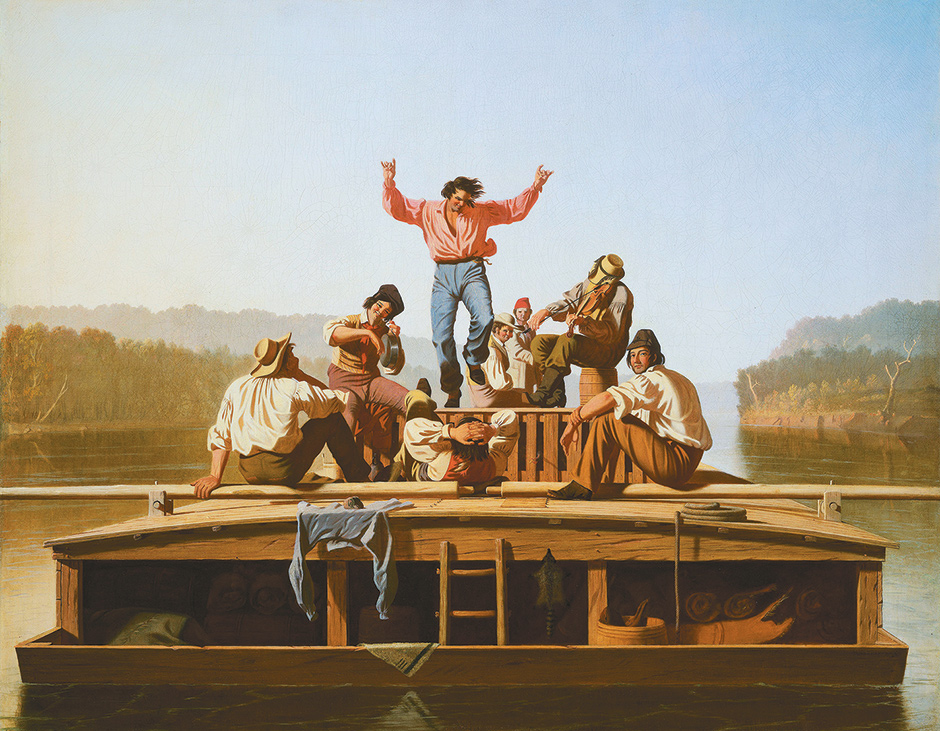In response to:
The Lure of Life on the Missouri from the June 25, 2015 issue
To the Editors:
In his review of the river paintings of George Caleb Bingham, now on exhibit at the Metropolitan Museum of Art [NYR, June 25], Sanford Schwartz finds that the individuality of the pictures is owing to a contradiction between “his quest to create scenes of a classical poise…and his doing so with such unlikely material.”
“Unlikely material” is Mr. Schwartz’s judgment not of Bingham’s paintings but of their human subjects. What he means by this is not apparent until fairly late in his review, when he says that “Bingham certainly sanitized his subjects.” And now I am sorry to have to quote Mr. Schwartz at some length:
His raftsmen rarely do anything more demanding than push their flatboats off into the river with a pole or dance a jig. He gives them the physical bearing and leisurely composure of gods, or, at least, sportsmen. In actuality, the flatboatmen were nautical versions of gas station attendants. On their rafts they carried cords of wood…to meet the passing steamboats…and supply them with fuel. They were known to be a rowdy, surly, and unkempt bunch.
A number of things are wrong here.
Like his apparent mentor, the Metropolitan’s caption-writer, Mr. Schwartz uses raftsmen and flatboats interchangeably as synonyms, and assumes that either a flatboat or a raft could be used to carry firewood to steamboats. A flatboat was used for transporting freight and could carry many tons, but downstream only. A raft was made of logs—or in Bingham’s paintings, squared timbers—to be transported, of course, only downstream. Both were equipped with long, heavy oars for steering, but they could not be rowed. Neither a flatboat nor a raft could have been used to supply firewood to a steamboat. Navigation of either a flatboat or a raft required great strength, skill, and knowledge—also courage, for the work was dangerous. The people who sold firewood to steamboats had first to cut the wood. And so there is no likeness whatever between Bingham’s river boatmen and gas station attendants.
There is, in fact, a lot of testimony to the rowdiness (I suppose also to the surliness and unkemptness) of some of the independent boatmen of the Mississippi drainage in Bingham’s time and earlier, and to the terrible “rough and tumble” fighting on the part of some of them. It is also imaginable and reasonably supposable that some of those boatmen were physically comely and wore eye-gladdening clothes, just as it is imaginable and reasonably supposable that some people of wealth and high culture might be rowdy, surly, and unkempt.
Wendell Berry
Port Royal, Kentucky
Sanford Schwartz replies:
I am thankful to Wendell Berry for noting the difference between rafts and flatboats. If neither carried wood, however, some vessel certainly did. Writers on Bingham make clear that servicing steamboats with wood, or fuel, was one of the jobs these men maintained. The stacks of cut wood can be seen in Bingham’s pictures. As for there being “no likeness whatever between Bingham’s river boatmen and gas station attendants,” I agree. That was my point. The artist’s concern was firstly with a classical, highly ordered sense of space, light, bodily bearing, and structure. He was not a realist. For his purposes the “courage,” “skill,” and “knowledge” of the rivermen were of secondary importance, as was a true account of their appearance and manner. Much of the continuing strength of Bingham’s art comes from the disjunction, which we sense intuitively, between what life on the river must actually have been and the immaculate classical tableaux he made of it.
This Issue
September 24, 2015
Urge
Hitler’s World
Trump




